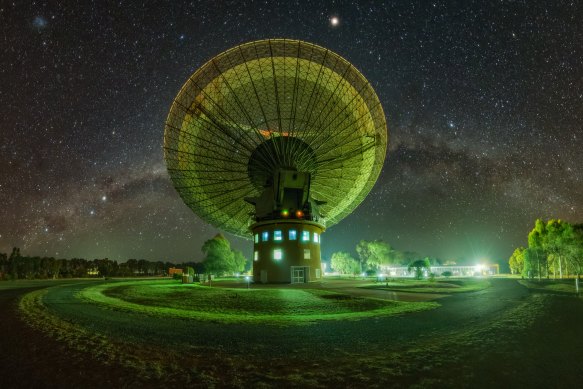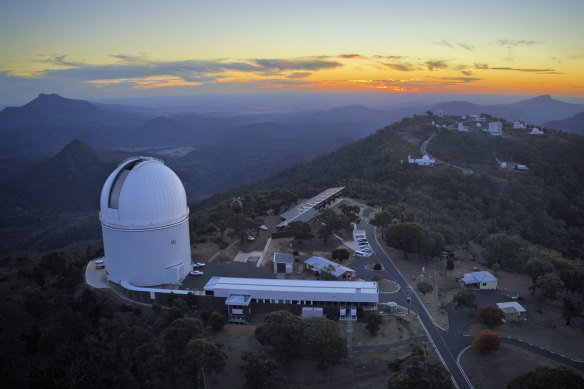Six must-see astronomical sites in NSW
CSIRO Parkes radio telescope

The CSIRO’s Parkes radio telescope has been tracking pulsar beams in the southern sky since 2004.Credit: Alex Cherney
This observatory amid huge white gums outside Parkes is most associated with pulsars, NASA moon missions and feel-good Aussie movie The Dish. You can’t peer at stars (the telescope detects distant radio energy) but the Discovery Centre gives you a 3D film tour of the universe and explains the facility’s considerable scientific achievements and research into gravitational waves, black holes and other mysteries. The most distant objects detected by the dish are 20,000 million light years away. A Public Art Trail in Parkes features astronomy-themed artworks, and July’s AstroFest is devoted to stargazing and astro-photography. See parkes.atnf.csiro.au
Virtual solar system drives

The drive up to Siding Springs Observatory, atop Mt Woorut, is beautiful.Credit: Destination NSW
The undulating roads that lead from five Central West towns (including Parkes) to Coonabarabran are lined by informational billboards depicting the planets, set out on a scale of one to 38 million to demonstrate the relative distance between them. While of passing interest, the drive is beautiful and the end point, representing the sun, is Siding Springs Observatory, whose several world-class telescopes are perched like a flock of alien spacecraft atop Mt Woorut. A viewing gallery inside the four-storey white dome that houses the Anglo-Australian Telescope relates the many significant research discoveries it has aided. See visitnsw.com
Warrumbungle National Park

The night sky filled with bright stars over the dark sky park in the Warrumbungles.Credit: Alex Aitken/Destination NSW
The star-spangled universe seen from rural Australia is always magnificent, but the extravagance of the Milky Way from this Dark Sky Park, uninterrupted by light pollution, is particularly breathtaking, and set against the jagged outlines of volcanic ridges. You can camp in the national park or stay in accommodation such as the off-grid Dark Sky Eco Resort and child-friendly Skywatch Observatory Domestays, which have powerful telescopes that allow you to squint at constellations, nebulae, meteors, the rings of Saturn in shimmering orange and green, and even the occasional passing satellite. See nationalparks.nsw.gov.au
Outback Astronomy

Outback Astronomy: take a tour of the big celestial sights in a light-free stargazing area.Credit: Destination NSW
You haven’t seen stars until you’ve seen outback stars, flung like glittering confetti across pitch-black skies. You can look up anywhere, but this Broken Hill tour operator has a light-free stargazing area and binoculars and telescopes that magnify the bedazzlement as you lounge back in a deck chair. Owners Linda and Travis Nadge take you on a tour of the big celestial sights but interesting minor constellations as well, and will regale you with the improbable science of black holes and collapsing stars. Bring warm clothes: the outback is nippy at night. The site has a bar and glamping and camping options. See outbackastronomy.com.au
Sydney Observatory

Look to the stars at the Sydney Observatory.Credit: Museum of Applied Arts & Sciences
Once a month, this heritage observatory hosts a free program of stargazing in the company of astronomers on the lawns, which overlook not only the heavens but the Harbour Bridge’s ironmongery. Some are timed to coincide with lunar eclipses. Telescopes highlight familiar constellations in extraordinary magnified detail such as the meteor shower and two bright stars Castor and Pollux that leap into view in the constellation Gemini. The events are enlivened by various food and wine stalls and music performances. See maas.museum
Bubbletent Australia

Watch the night come alive from your luxury Bubbletent.Credit: Destination NSW
Sometimes the heavens should be absorbed without the intermediary of scientific equipment. For the ultimate romantic star experience, check into one of three pods perched on an escarpment above the gloriously beautiful Capertree Valley near Lithgow in the Blue Mountains. They provide glamping luxury with virtually no barrier between you and the night sky: the pods are see-through, the shower is outdoors, and you can even sink into an outdoor wood-fired bath as sunset flames and stars emerge. And okay, there is a telescope too if you can’t resist a closer look at the moon’s pitted surface. See bubbletentaustralia.com
The writer travelled as a guest of Tourism NSW.
Sign up for the Traveller Deals newsletter
Get exclusive travel deals delivered straight to your inbox. Sign up now.